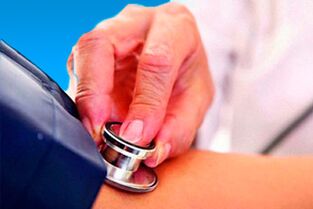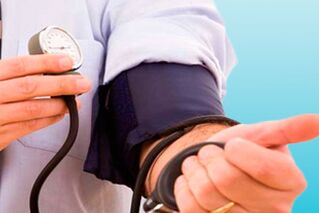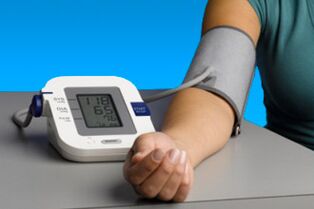
Violation of blood pressure provokes failures of the whole organism. Despite the fact that this disease cannot be fully cured, the course of the disease may become less apparent and problematic for the patient.
Michen organs
Arterial hypertension is a chronic disease associated with increased pressure within the vascular walls. In this case, it is very important to distinguish between rare situations when a person enhances the true pressure and appearance of this disease. An increase in time can occur for various reasons, and often do not repeat it soon. The cause may be a person's excitement, hormonal dysfunction or damage.
Asking the question of what arterial hypertension is, it is necessary to deal with the term "hypertension". This is a temporary increase in blood pressure above 140/90. But hypertension in medicine is called a condition in which a person has high high indicators. They rarely fall under these numbers themselves.
The negative side of this disease is that not only the cardiovascular system suffers from chronic high pressure. In medicine, there is such a thing as the target organs. The essence of the problem is that constantly increased blood pressure has a negative effect on a number of organs - the heart, kidneys, brains and retina. The disease will adversely affect the whole body, but they suffer in the first place. Even the principle of classification of the disease depends on which body a negative effect was exerted.
The stages of the disease
The disease has different forms that depend on that principle to classify. They can depend on the origin, course and blood pressure level. The easiest form of arterial hypertension is easier, as patients can detect their pressure at home.
Like other diseases, the development of hypertension has several degrees that worsen only without the necessary treatment. There are norms that help determine the stage of the disease. You cannot draw conclusions after one or two pressure measurements of a person, as this approach can give incorrect indicators. If a person before that had taken certain medicines or there was an emotional growth, and no emotion was worse or better, the indicators could change. This will not allow you to see the true picture of the patient's health.
Do not confuse high pressure, which is within the normal range, with the way arterial hypertension manifests. Pressure of 120/80 is considered normal for the human body, but pressure can also be classified as 129/84. Pressure is considered to increase by 139/89, but is not classified as a degree of hypertension. Hypertension is considered a pressure exceeding 140/90.
Table 1. The degree of hypertension and pressure level
| The degree of arterial hypertension | indicator |
|---|---|
| rate | From 120/80 to 139/89 |
| 1 degree of hypertension | From 140/90 to 159/99 |
| 2 degrees of hypertension | From 160/100 to 179/109 |
| 3 degrees of hypertension | From 180/110 and above |

In addition to the definition of "hypertension" and the classification of the disease according to the degree of development, there is also a unit for primary and secondary hypertension. Starting develops as an independent pathology, and often other problems in the human body were not found in this case. If we are talking about secondary hypertension, then it becomes the result of existing diseases in the human body.
First degree
It is considered to be a mild form of the disease, blood pressure indicators do not exceed 160/100, and attacks, mainly without severe consequences. Arterial Hypertension of degree 1 is characterized by spasmodic disorders that occur in heart work. Periods of irritation can hardly be called rare, but due to a slight manifestation and chronic course of the disease, they suffer from the patient quite easily. The irritation alternates with normal indicators, during this period the patient does not feel the symptoms of the disease.
To adequately assess the situation, it is necessary to perform pressure measurements using a tonometer several times a day. Usually this is done three times a day in the absence of emotional outbreaks or other reasons that may affect a short -term change in blood pressure.
First -degree arterial hypertension has its own symptoms, which patients often cannot perceive seriously. The disease can appear with headaches, rapid heartbeat or pain on the left side in the sternum. Patients are often confused by the fact that first -degree hypertension is rarely characterized by symptoms.
But even a small degree of hypertension can have its own complications, which are fraught with serious disorders in the human body. This:
It is wrong to assume that the arterial hypertension of 1 degree can pass without a trace if treated with medication. It can be argued that a patient suffering from first -degree hypertension has a risk of complications. Statistics show approximately 15% of such probability.
When the patient was diagnosed with 1 degree hypertension, the situation is as follows: high pressure can be driven by narrowed gaps on the boat, which leads to insufficient nutrition of body tissue. In the absence of a normal amount of nutrients and oxygen in cells, necrosis develops. Initially, this process is not visible, but over time, some organs in the patient's body, and not just certain cells, can occur over time. Lack of treatment provokes ischemic stroke.
If the patient has high blood pressure, then the first -degree hypertension also gives a very high risk of developing heart problems.
Changing the indicators in the largest direction gives an extra load on the heart, which, trying to push the blood through the narrow vessel gaps, is overloaded. Everyone knows that with extra load, the muscles begin to grow, this is also the case with the heart tissue. It may seem that the risk hypertension of scale 1 reduces the risk because the heart can pump the blood more effectively, but this is not completely true. Cardiomyopathy can squeeze the vessels in the vicinity, and even provoke death.
The second degree

In the second degree of arterial hypertension, the patient will be at the level of 180/110 mm Hg. In this case, patients in patients are much greater than with 1st degree hypertension, the risk of complication in which it occurs less frequently.
The second degree of hypertension is characterized by the fact that pressure comes extremely rarely to normal, it can decrease and increase, but not reach permissible limits. Typically, degree 1 degree hypertension has the risk of being moved to the same 2 degree disease, then it is possible to determine the occurrence of benign or malignant arterial hypertension. To clarify what kind of arterial hypertension it has, what it carries and what risks arise helps develop the pathology.
In patients, vascular deficiency, head pulsation, hyperemia, visual visual problems and hypertension crises are added to the already known symptoms. The latter's problem is that the pressure can change dramatically by 59 units, which adversely affects the patient's body. In the second degree of hypertension, complications are possible:
The peculiarity of this degree of development of hypertension is that the loss of the target organs occurs. In patients with such a diagnosis, hemorrhages are possible in one of the organs. This is due to the fact that, on a later degree of arterial hypertension, blood vessels lose their former elasticity and may be much easier to collapse. There are also serious risks of forming blood clots in the blood vessel walls, the lumen in which it has already been reduced.
Due to the serious problems that can occur in the second degree of arterial hypertension, the patient may receive disabilities. Most often they give 3 groups. But that does not mean that it is enough for the patient to measure his pressure several times and show that it exceeds the permitted rate. The commission takes into account the complications that appeared against the backdrop of this disease, collects information about hypertension, as well as about the working conditions of the patient - only after that can we talk about getting a cash benefit.
The commission takes into account the complications that appeared against the backdrop of this disease, collects information about hypertension, as well as about the working conditions of the patient - only after that can we talk about getting a cash benefit.
The paradox of the situation is that some patients try to get this help in the first symptoms, while others, on the contrary, hide their illness. Most often this is done by employees who can be fired due to the working conditions that will be supported after this (more ill rest, an increase in annual leave). But we must not forget that in the second degree of hypertension an additional load can have severe consequences that will rapidly worsen the disease.
It is worth noting a special case that is possible in the second degree of arterial hypertension. When it comes to malignant pathology, the commission can designate 2 disability groups. Men over 60 years old, women over 55, as well as patients who have irreversible defects found inability to life. This means that there will be no need to pass the commission every year to confirm the status.
The third degree
By means of a person's pressure, the rate of the disease can be determined. When indicators begin to reach extremely high rates - from 180/110 mm Hg, the patient is diagnosed with a third, severe degree of hypertension. In this case, the complications are very serious, most of them, with premature provision of medical care, can lead to death. It can be a stroke, heart asthma, myocardial infarction, kidney failure and other diseases.
By assessing the seriousness of this degree, patients are assigned 1 disability group. By assessing the degree of risk of developing diseases, the patient should obtain rehabilitation without failing. There is no need to talk about treating this degree, but this approach will help to avoid premature death.
There is a concept of fourth degree hypertension. In this case, it is quite difficult for a person to help because he is practically on the verge of death. Medications help alleviate symptoms and severely reduce pressure levels. The hypertonic crises are pronounced and very frequent.
The degree of risk
Typically, when you diagnose the patient, the degree of illness and risk is indicated. This indicator can affect age, gender, overweight, bad habits and other factors.
There are four degrees of risk. The most optimal hypertension of first -degree risk 1 is considered, the probability of developing side diseases is low, less than 15%. First -degree arterial hypertension (risk 2) is one of the most popular diagnoses. This is due to the fact that few patients lead such a lifestyle that would not in any way complicate the disease. When diagnosed arterial hypertension of scale 1 (Risk 2), the probability of complications varies from 15% to 20%.
The risk of 3 degrees is 20-30% the probability of developing diseases. It's called high. There are also 4 degrees when the probability of developing pathologies exceeds 30%. All risk predictions are calculated for the next 10 years in the absence of patient lifestyle changes.
Depending on the lesion of the patient's internal organs, doctors indicate the stages and degree of hypertension due to indicators. It is the stage of the disease that determines which organs are damaged.
Phase 1 of the disease, in fact, has no indicators, because only an increase in pressure occurs, and the human organs are not damaged. With phase 1 hypertension, the patient will have optimistic forecasts for the future.
In 2 stages of the disease, the first signs of narrowing of the vessels are found, plaques appear and creatinine in the blood plasma increases. All changes that occur in the internal organs usually do not have serious changes, and with proper treatment, complications can be prevented.
Unlike phase 2, the third is characterized by specific diseases, and not just partial changes. This is pronounced arterial hypertension, which means that in patients, the risk of transferring myocardial infarction, stroke, the onset of cardiac and renal failure and other characteristic diseases increases several times.
Characteristics of the disease

Arterial hypertension is common all over the world, and is the most common in highly developed countries. First of all, this is due to the fact that active life means communicating with a large number of people, and this requires different, bad and good emotions, which leads to a constant increase in pressure.
For many people, it is not even difficult to answer the question of what is it? The prevalence of the disease makes it possible to call this pathology a wound of the 21st century. There is such a thing as arterial hypertension syndrome, it is a chronic vascular deficiency, the same hypertension. It is violated in the work of ships provoking arterial hypertension syndrome.
Gestational arterial hypertension is extremely negative for a woman. The appearance of this pathology is associated with pregnancy, a woman during this period is contraindicated in taking most medications.
At the same time, the lack of treatment can have extremely negative consequences. Statistics show that gestational arterial hypertension is the cause of about one -third of cases of mother's fatal outcome during childbirth, and can also provoke fetal death or premature birth.
Apart from the fact that the patient should know the symptoms of hypertension, and what is, it is necessary to contact the hospital on time, because treatment of the disease is much easier in the first stage. It is necessary to consult with the doctor who participates in the dose increase or the inclusion of other medicines. Self -medication can worsen the disease.























